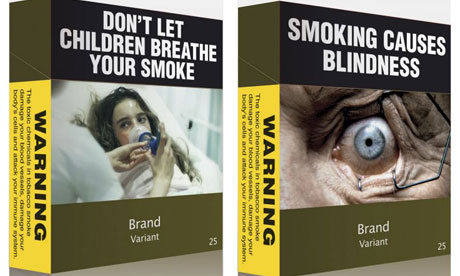Plain packaging seems to make cigarettes less appealing and increase urgency to quit smoking
Plain packaging for cigarettes seems to make tobacco less appealing and increase the urgency to quit smoking, suggest early findings from Australia, published in the online journal BMJ Open.
Australia formally introduced plain brown packaging, accompanied by graphic health warnings taking up three quarters of the front of the pack, for all tobacco products on December 1 2012. So far, it is the only country in the world to have done so.
The researchers wanted to find out what effects the policy was having in the early stages, and whether it helped curb the appeal of tobacco, emphasise its harms, and boost thoughts of quitting among smokers.
They therefore interviewed 536 cigarette smokers in the Australian state of Victoria during November 2012 when plain packs were already available, in the run-up to, and immediately after, implementation of the legislation requiring all tobacco sold at retail outlets to be contained in plain packs.
The interviewees were all taking part in the annual phone Victorian Smoking and Health Survey, which is a representative survey of adults in the state.
Almost three out of four (72.3%) were smoking cigarettes from plain packs while the remainder (27.7%) were still using branded packs with smaller health warnings.
 The smokers were asked whether they were as satisfied with their cigarettes as they were a year ago, and whether they felt the quality was the same. They were also asked how often they thought about the harms of smoking and about quitting smoking, and if they approved of the plain pack policy. And they were asked if they thought the harms of smoking had been exaggerated.
The smokers were asked whether they were as satisfied with their cigarettes as they were a year ago, and whether they felt the quality was the same. They were also asked how often they thought about the harms of smoking and about quitting smoking, and if they approved of the plain pack policy. And they were asked if they thought the harms of smoking had been exaggerated.
The results indicated that perception of exaggerated tobacco harm or the frequency with which smokers thought about the damage cigarettes might be doing to them differed little between the two groups. But plain pack smokers were 51% more likely to back the plain pack policy than were brand pack smokers.
And compared with smokers still using brand packs, the plain pack smokers were 66% more likely to think their cigarettes were poorer quality than a year ago. And they were 70% more likely to say they found them less satisfying.
They were also 81% more likely to have thought about quitting at least once a day during the previous week and to rate quitting as a higher priority in their lives than were smokers using brand packs.
As the date for the legislation drew nearer, and more of the sample were smoking from plain packs, the responses of those smoking brand packs more closely matched those of plain pack smokers in terms of smoking’s appeal.
 This could simply reflect the reduced likelihood of being able to smoke from a brand pack or “social contagion,” suggest the authors.
This could simply reflect the reduced likelihood of being able to smoke from a brand pack or “social contagion,” suggest the authors.
But, they conclude: “The finding that smokers smoking from a plain pack evidenced more frequent thought about, and priority for quitting, than branded pack smokers is important, since frequency of thoughts about quitting has strong predictive validity in prospective studies for actually making a quit attempt.”
And they add: “Overall, the introductory effects we observed are consistent with the broad objectives of the plain packaging legislation. We await further research to examine more durable effects on smokers and any effects on youth.”
###
[Introduction effects of the Australian plain packaging policy on adult smokers: a cross sectional study doi 10.1136/bmjopen-2013-003175]
###
Stephanie Burns
sburns@bmj.com
44-020-738-36920
BMJ-British Medical Journal